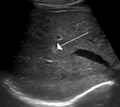Hemangioma
| Hemangioma | |
|---|---|
| Synonyms | |
| Pronounce | N/A |
| Specialty | N/A |
| Symptoms | Red to purple raised lesion |
| Complications | Ulceration, bleeding, infection |
| Onset | Infancy |
| Duration | Usually resolves by age 10 |
| Types | N/A |
| Causes | Genetic factors |
| Risks | Premature birth, female gender |
| Diagnosis | Physical examination, imaging studies |
| Differential diagnosis | N/A |
| Prevention | N/A |
| Treatment | Observation, beta-blockers, laser therapy |
| Medication | N/A |
| Prognosis | N/A |
| Frequency | Common |
| Deaths | N/A |
A hemangioma is a benign tumor of blood vessels, often appearing as a red to purple raised lesion on the skin. These lesions are most commonly found in infants and are known for their rapid growth during the first year of life, followed by a slow involution phase.
Signs and Symptoms[edit]
Hemangiomas typically present as a red to purple raised lesion on the skin. They can vary in size and may appear anywhere on the body, but are most commonly found on the face, scalp, chest, or back. While most hemangiomas are superficial, some may have a deeper component, leading to a bluish hue.
Complications[edit]
Although hemangiomas are generally benign, they can lead to complications such as ulceration, bleeding, and infection. In rare cases, they may interfere with vital functions if located near the eyes, nose, or mouth.
Causes[edit]
The exact cause of hemangiomas is not well understood, but they are believed to result from genetic factors. Certain risk factors, such as premature birth and female gender, have been associated with a higher incidence of hemangiomas.
Diagnosis[edit]
Diagnosis of hemangiomas is primarily based on physical examination. In some cases, imaging studies such as ultrasound or MRI may be used to assess the extent of deeper lesions.
Treatment[edit]
Most hemangiomas do not require treatment and will resolve on their own by age 10. However, in cases where treatment is necessary, options include observation, beta-blockers such as propranolol, and laser therapy.
Prognosis[edit]
The prognosis for hemangiomas is generally excellent, with most lesions resolving completely by age 10. However, some may leave residual skin changes or scarring.
See Also[edit]
References[edit]
<references/>
External Links[edit]
-
Hemangioma
-
Hemangioma
-
Hemangioma
-
Hemangioma
Ad. Transform your life with W8MD's Budget GLP-1 injections from $75


W8MD offers a medical weight loss program to lose weight in Philadelphia. Our physician-supervised medical weight loss provides:
- Weight loss injections in NYC (generic and brand names):
- Zepbound / Mounjaro, Wegovy / Ozempic, Saxenda
- Most insurances accepted or discounted self-pay rates. We will obtain insurance prior authorizations if needed.
- Generic GLP1 weight loss injections from $75 for the starting dose.
- Also offer prescription weight loss medications including Phentermine, Qsymia, Diethylpropion, Contrave etc.
NYC weight loss doctor appointmentsNYC weight loss doctor appointments
Start your NYC weight loss journey today at our NYC medical weight loss and Philadelphia medical weight loss clinics.
- Call 718-946-5500 to lose weight in NYC or for medical weight loss in Philadelphia 215-676-2334.
- Tags:NYC medical weight loss, Philadelphia lose weight Zepbound NYC, Budget GLP1 weight loss injections, Wegovy Philadelphia, Wegovy NYC, Philadelphia medical weight loss, Brookly weight loss and Wegovy NYC
|
WikiMD's Wellness Encyclopedia |
| Let Food Be Thy Medicine Medicine Thy Food - Hippocrates |
Medical Disclaimer: WikiMD is not a substitute for professional medical advice. The information on WikiMD is provided as an information resource only, may be incorrect, outdated or misleading, and is not to be used or relied on for any diagnostic or treatment purposes. Please consult your health care provider before making any healthcare decisions or for guidance about a specific medical condition. WikiMD expressly disclaims responsibility, and shall have no liability, for any damages, loss, injury, or liability whatsoever suffered as a result of your reliance on the information contained in this site. By visiting this site you agree to the foregoing terms and conditions, which may from time to time be changed or supplemented by WikiMD. If you do not agree to the foregoing terms and conditions, you should not enter or use this site. See full disclaimer.
Credits:Most images are courtesy of Wikimedia commons, and templates, categories Wikipedia, licensed under CC BY SA or similar.
Translate this page: - East Asian
中文,
日本,
한국어,
South Asian
हिन्दी,
தமிழ்,
తెలుగు,
Urdu,
ಕನ್ನಡ,
Southeast Asian
Indonesian,
Vietnamese,
Thai,
မြန်မာဘာသာ,
বাংলা
European
español,
Deutsch,
français,
Greek,
português do Brasil,
polski,
română,
русский,
Nederlands,
norsk,
svenska,
suomi,
Italian
Middle Eastern & African
عربى,
Turkish,
Persian,
Hebrew,
Afrikaans,
isiZulu,
Kiswahili,
Other
Bulgarian,
Hungarian,
Czech,
Swedish,
മലയാളം,
मराठी,
ਪੰਜਾਬੀ,
ગુજરાતી,
Portuguese,
Ukrainian



